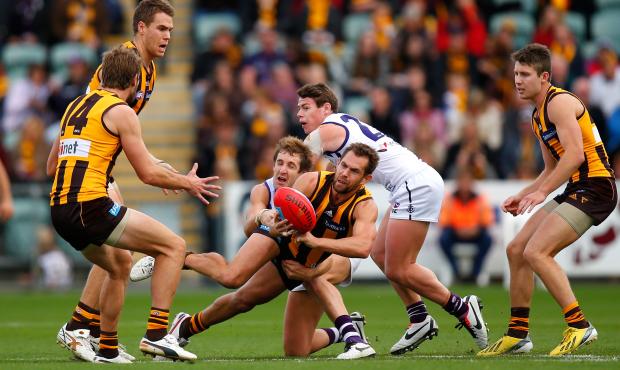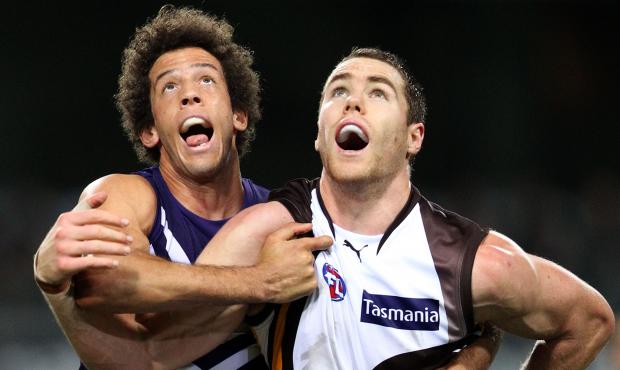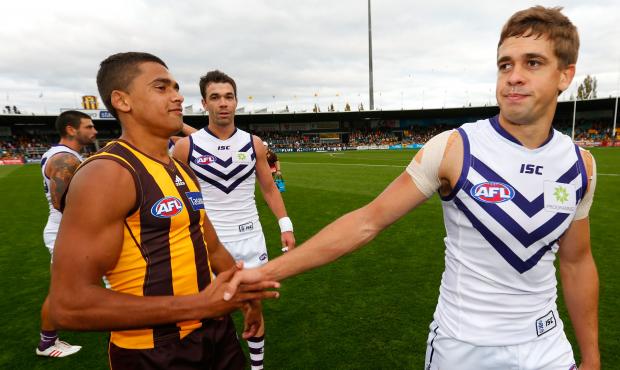Crowley to Mitchell – why? Sam Mitchell has been in sensational form across the last month. His stats read: Round 22 -27 possessions, Round 23 - 26 possessions, Qualifying Final - 29 possessions, Preliminary Final - 38 possessions.
Let’s take a look at the strengths of Ryan Crowley.
Firstly, if Mitchell plays only to his strength of accumulating contested possessions around the stop plays he becomes a ‘sitting duck’. Crowley loves this type of contest. He has a strong body and tough mental strength, allowing him to get into a wrestle when he wraps himself inside his direct target. As he has no desire to ‘win’ the football, his major focus is to deprive his direct opponent of any possession, thus a lack of movement around the stoppage will work to his favour.
Once Crowley has taken away Mitchell’s ball winning opportunities around the stop plays, his elite physical conditioning allows him to spread when Fremantle are in possession (forcing his direct opponent to defend). Mitchell will have noted that once the ball has left the 30m area where he and Crowley are located, Crowley will go straight back to his ‘stopper’ role.
Ryan Crowley does kick goals when taken into Fremantle’s forward half of the ground. His teammates look for him, knowing that his direct opponent can at times be more concerned with tracking the football rather than defending Crowley in this area of the ground.
So how does Sam Mitchell and Hawthorn combat the negating tactics.
Physicality on Crowley is a must. Hawks players must be given the task of physical pain on Crowley (as we were accustomed to seeing in the days when Dermot Brereton offered protection to John Platten). They will need to come off the line at centre half forward, steam in like a missile directly at the opposition tagger, and make legal heavy contact.
Hawks players can try and block for Mitchell around the stoppages, but this sometimes can allow Fremantle to go third-man up because the player trying to block for Mitchell forgets about his own direct opponent, example Mundy.
The best tactic for me on the day is to always have Mitchell in motion, moving in a forward direction towards goal. The strategy behind this is if Mitchell starts in the middle of the ground but then pushes hard downfield to play as a forward, then the likes of Hodge or Rioli, who demand great respect, start at half-forward and move up into the midfield area. This will stop Crowley from trying to run off Mitchell and, more importantly, Mitchell becomes a moving target. If Mitchell stays out of the Hawthorn defensive area (Fremantle forward line) Crowley does not get the chance to hurt on the scoreboard.
How do Fremantle structure up defensively:
Fremantle defensive system
• Work ethic
• Strong bodies inside the contest
• Speed on the outside of the contest
• Manic tackling pressure by all
• Team before individuals
• Tall player down line for outlet kicks
Fremantle have the philosophy to dominate the outside territory around the contested situations. This ownership of territory stops opposition teams having space to create uncontested chains of possessions out of the contested situations.
Rule number one.
They always only ever have one Fremantle player focusing in on the disputed ball around the contested ball. If that player misses his chance to win the football, the next closest Fremantle player will go hard at the disputed contest. This ensures that Fremantle never have two to three players going for the same football, which means if the opposition win, the Dockers will never get beaten on the outside of the contest with numbers. The Fremantle system does not allow handball options out of congestion, rather a forced quick kick, often falling into the waiting arms of a well-placed Docker.

Rule number two.
If the opposition win the ball they always only have one tackler that commits to the opposition player with the football. This closest player zeroes in on the ball carrier while everybody around the 10-20 meter area around the ball man up the handball receiver options. This strategy allows Fremantle many tackle opportunities to get the football back. This relentless pressure on the opposition makes teams abandon the handball option and quick kick the ball out of the congested situation. As mentioned previously, Fremantle always have a player positioned 30m behind the congestion to intercept this quick kick ball.
Rule number three.
When Fremantle intercept a mark in the back 50, they have mentality to start reconstructing their defensive mechanisms, even though they are in control of the football. The first thing that happens is that every Fremantle player without the ball in the area will spread quickly in all different directions to make sure that no Fremantle player is within 20 metres of a teammate.
This allows for two things. Firstly, the player with the ball can easily find a loose option to release to. And, secondly, by spreading far and wide they own the majority of the ground and should they turn the ball over, there is no free space for opposition to attack.
Possession in the defensive area is all about short kicks, uncontested marks and finding the loose player. Controlling the ball in this area forces the opposition to have to come forward to defend opening space when they transfer the ball through the midfield area and going forward to a one vs. one contest. Since the opposition have had to come forward to their direct opponents, should Fremantle turn the ball over they are very close to switch into defensive mode.
Rule number four
If the ball has been turned over by Fremantle, all players on the ground are expected to switch quickly into defence. The forwards slide up into the midfield area, the midfielders push back into the defensive area blocking up leading space and the defenders work as a team in assisting each other with being the third man in for any aerial balls.
Rule number five
Players must have the ability to identify when to go fast with the football and when to go slow. This tempo football allows the numbers to be resourced where the football is going to, but, more importantly to set up defensively behind the football to restrict the opposition of any chance of goals from turnovers. Forward pressure and turnover goals make up a huge percentage of the teams scoring power.

Will the Hawks need Max Bailey to play the entire match.
In a word, yes.
Bailey and Hale are up against Sandilands and Clarke. Clarke is the runner who covers a lot of ground. When he is playing in the forward line they use him to come up the ground to go third man up. This demands his defender go with him and man up, opening up the forward-line for Pavlich to go one out against his direct opponent.
Sandilands plays a more robust style. He is always available down the line for the release kick when Fremantle cannot switch the ball to the open side of the ground. He also sits down the line when the opposition are in possession of the football. Fremantle work hard not to allow the opposition to switch the ball to the open side of the ground, therefore when they are forced to kick long down the line Sandilands is positioned for the intercept.
I think Bailey and Hale must consider two options. They could position themselves against the two ruckmen down the line to contest the mark and bring in their crumbers (Rioli, Bruest, Burgoyne) or at times they could run to the open side of the ground to be a switch option or to get an extra number to this area. This may take Clarke and Sandilands away from their team system of being just down the line from where the ball is positioned. It’s going to be a huge task for Bailey and Hale, but it will have an equally huge bearing on the result.
Tactics that won’t be obvious to the naked eye:
Hawthorn
1. Where they position Crowley’s direct opponent.
2. Ball movement by the Hawks to be a lot quicker than we have seen to get through the defensive zone.
3. Positioning of the ruckman when the ball is in motion to limit the effectiveness of Sandilands
4. How to stop Michael Johnson being a loose player in the Hawthorn forward-line. Hawthorn will not want Johnson to have the freedom to be third man up at the contest.

Brad and Stephen Hill will break a 101-year record when they meet in the Grand Final. Picture: AFL Media
1. De Boer, playing a defensive half forward role on the likes of Hodge or Birchall
2. Playing a seventh defender at stoppages, limiting marking opportunities for Roughead, Franklin and Hale.
3. Controlling the tempo of play.
4. Fremantle forwards pushing up into the midfield space quickly when they lose possession of the football; this allows the Fremantle midfielder to clog up Hawthorn’s forward leading space. Look to Mayne, Ballantyne, Walters to test the likes of Gibson, Guerra, and Stratton.
What will be keeping the coaches awake this week
Clarkson: Hawthorn’s last loss was to Richmond at the MCG in round 19. Why do I bring up this game? It demonstrated how Hawthorn struggled against the strong bodies in the midfield. Richmond had 370 possessions compared to the Hawthorn’s 330. This domination by the Richmond midfield group restricted the Hawks’ inside 50 entries – having only 46 on the day when they are normally up around 55 inside 50’s per game. I believe the Fremantle midfield can do a similar job to Richmond and dominate the possession count, which will limit Hawthorn’s forward entries.
Fremantle do have some injury vulnerability in their defensive group (McPharlin, Johnson) so if Hawthorn can have 50-plus forward entries, it will test these defenders.
Fremantle small forward brigade (Ballantyne and Walters) will cause some headaches for the Hawthorn coaching staff. At times, Hawthorn likes to play a more zoning style in defence rather than a close checking man-to-man style. If the Hawks play their normal style against these two small crumbing forwards then it may cost them some very soft goals.
For Ross Lyon, his biggest concern would be the health of certain key players. McPharlin looked sore against the Swans. Since the Dockers dominated, he was never tested on the lead or by travelling distances. The other key defender in Johnson has come back from a calf injury and still looked slightly concerned about his injury, receiving plenty of treatment whenever off the ground. Hawthorn will make these two players cover a lot more ground than Sydney did. If McPharlin plays on Franklin, Hawthorn will look to use him up the ground, testing his direct opponent for the duration of the game.
Who wins and why?
I think the game will be won or lost in the midfield by the Hawks. They will require their big bodies in Mitchell, Hodge, Sewell, Lewis, and Burgoyne to match the likes of Mundy, Fyfe, Barlow, and Crowley one-on-one. Stoppages are where you can get a look at scoring against Fremantle, especially from a centre bounce; if you can get forward direct from the centre square, Hawthorn forwards will have one-on-one opportunities.
If Hawthorn can dominate the possession count, I believe that their forward line is too talent-laden not to kick a winning score. Hawthorn must be accurate though. It’s all about scoreboard pressure and keeping the scoreboard ticking over.


